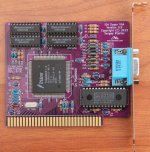mmruzek
Experienced Member
Hello, I have been exploring options for creating a VGA card for the PC-Retro from scratch and there is alot of terrific information available from the S-100 guys and Sergey. (Thanks!) I just happened to come across this manual for a Winsystems VGA card that not only includes a parts list, it also has the circuit schematic. I don't know if this is already well known and out there, but this is the first time I've seen it... so here is a link to the PDF for reference.
http://www.winsystems.com/manuals/LPMMCM-SVGA.pdf
Michael
http://www.winsystems.com/manuals/LPMMCM-SVGA.pdf
Michael

